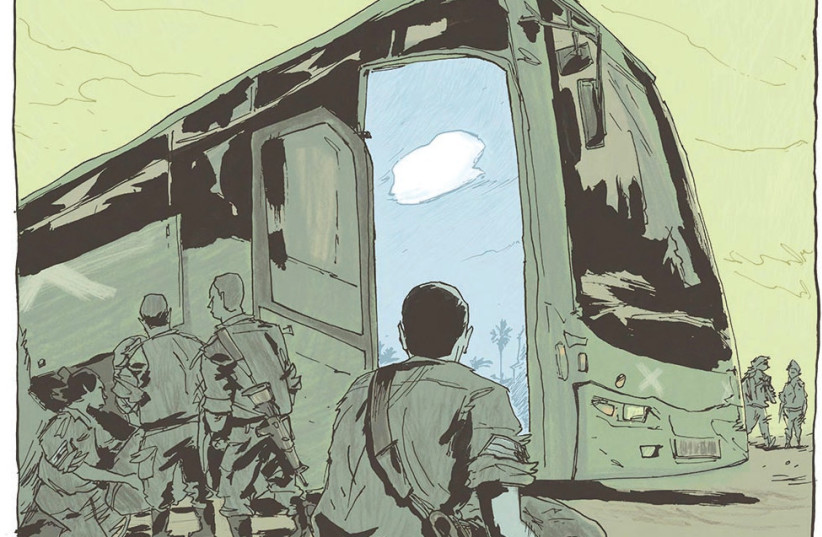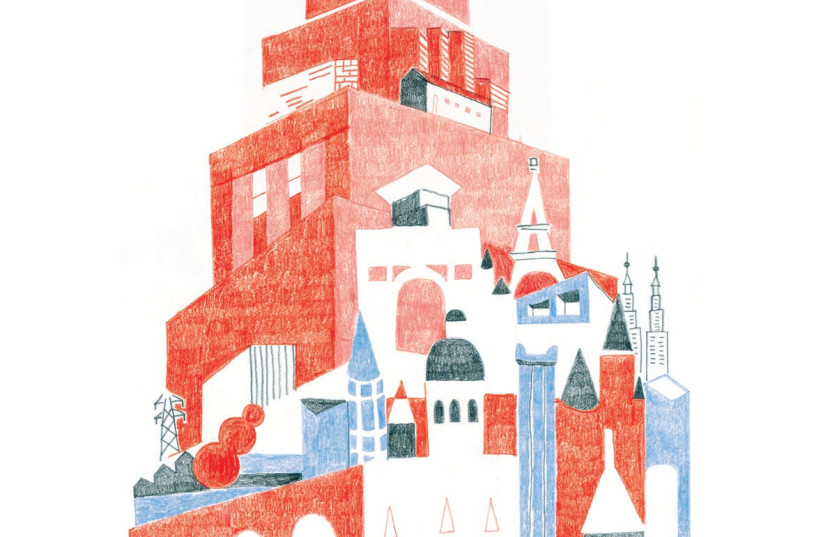Jerusalem has been called many things, and described in numerous ways, over the millennia of its troubled and colorful existence, but linear is probably not one of them. Then again, there are lines all over the place. One could cite those that delineate the famed Jerusalem building facing stone or, perhaps a little whimsically, the tracks of the light rail that traverse the length of Jaffa Road.
Considering the primary location of the annual Outline Festival, the latter are a more pertinent urban element, as the sixth edition of the illustration- and words-based artistic event takes place in the city, from August 17-23.
What happens in the Jerusalem Outline Festival?
As has become traditional since the festival’s inception, leading illustrators, animators, designers and multidisciplinary artists will unfurl their creations at various spots along Jaffa Road, as well as several slightly more distant venues, taking in a vast array of aesthetics, ideas and styles in the process.
All told, Jerusalemites and visitors to these parts will be able to view 14 al fresco solo and group exhibitions, free of charge, as Outline adds even more color to a city that comprises a uniquely multihued, multilayered human and cultural mosaic. There will also be live shows, workshops for kids and adults, lectures, and a bunch of other events for culture consumers and others just looking for a fun day out.
The festival is overseen by the Beta art gallery on Jaffa Road, near Mahaneh Yehuda, and its director Ofira Levanon, with noted illustrator Noa Kelner serving as artistic director, under the aegis of the Jerusalem Municipality and with the support of the Jerusalem Foundation.

As festivals go – and there seems to be literally hundreds of them going on around the country during the year – Outline is one of the more visually arresting and intriguing of them. With shows strategically positioned practically everywhere along the city’s principal artery, it is possible to roam the main thoroughfare, side streets and alleyways that lead off from Jaffa Road, taking in the artists’ colorful and alluring works.
You might be on your way somewhere, or just be moseying around checking out the urban scene. At its most basic level, the Outline spread makes for an attractive and eye-opening experience.
An attractive and eye-opening Jerusalem experience
Each festival program follows a particular theme, and this year’s subject is “Chazarot,” which could translate as “repetition” or “return.” That leaves the artists with plenty of scope for creative and intellectual maneuver, and they appear to have taken full advantage of the thematic leeway. The cyclic substratum to the exhibitions meanders every which way, as the illustrators and wordsmiths explore the margins and seams of the topic. The festival also tends to look at interfaces between illustrative and textual spheres.
THAT IS evident in some of the exhibits in the “Time After Time” show that occupies the pedestrian tunnel between the bus station and the Yitzhak Navon Train Station, curated by Gilad Seliktar. Seliktar opted for an interesting riff on the idea of repetition. He asked the six participants, all graduates of the Bezalel Academy of Arts and Design’s department of visual communication where, incidentally, the curator serves as a lecturer, to produce two readings of the same place.
One interpretation was to be an instinctive take, the result of a brief peek at the spot. The other was to be the result of a lengthy considered observation of the milieu, evoking a layered narrative.
Seliktar’s curatorship is also a thematically apt development. “I was responsible for an exhibition in the underpass last year too,” he chuckles. “I knew the place and I was intrigued by the fact that there are two sides, two walls, to the tunnel.”
That, he feels, offers fertile ground for a double-take approach. “You might focus more on a particular side, depending on the direction you’re coming from. And, on the way back, you’ll probably take more notice of the other side. Being familiar with the space, from last year, gave me an advantage this year.”
First, he had to settle on a name for the exhibition. “As soon as I’d decided on ‘Time After Time,’ things fell into place,” he says. “After that, I could ask the artists to return to the same place, and they could take the theme in any direction they wanted.” That could take on tangible form or follow more emotional or cerebral lines.
“They could return to the same place along their own timeline, in their own mind, or in their own memory.”
That comes through palpably, for example, in the brace of illustrations by Peled. “The Second Lebanon War broke out in 2006,” she recalls. “My family and I live at Misgav near Karmiel, although we spent most of the war at my grandmother’s house in Zichron Ya’acov. That was the summer before I entered sixth grade.”
When a truce was achieved, Peled and her family returned home and witnessed some of the scars inflicted by the war on the area. Two years ago, images of what she saw as an 11-year-old came flooding back as, in one illustration, she relates the events and her feelings at the time.
In the second work, she returns to the here-and-now, looking at the new neighborhood that has sprung up in the interim, papering over the damage inflicted by rockets launched from the North 16 years earlier. The pictorial and textual aspects of both works pull on the heartstrings and convey a sense of touching reminiscence.
THE PING-pong dynamic between the image of a fleeting moment, and the portrayal of a narrative continuum reminded Seliktar of an important juncture in the French avant-garde movement of the early 1960s. “This put me in mind of the film La Jetée, by [French multidisciplinary artist] Chris Marker,” he notes. Movement, and relating to the absence and acceleration thereof, can produce compelling visual and aesthetic results.
“It is a movie which is completely made up of still photography,” Seliktar explains. “There is the element of traveling through time, and also memory. The whole film is frames, with narration, that change at a repetitive rate. After a while, the speed gradually picks up, until you see movement.”
That has the effect of transforming the base format and it is something, Seliktar feels, that informs “Time After Time” too. “I thought that if we see a moment frozen in time, and then in movement, that creates a situation in which the relationship between the moments changes.”
It is also impacted by the fact that the observers of “Time After Time” will also view the works while they are moving unless, that is, they decide to linger a while and consider the illustrations from a more relaxed pose.
Seliktar says there is a strong likelihood of the pictures stopping Jerusalemites in their tracks. “The works are 1.10 m. by 1.10 m., like giant comics frames. In a location like the tunnel, and with that size, that format has a lot of power. You get a completely different experience with dimensions like that. You experience it on various levels.”
With the benefit of hindsight, Seliktar says he is confident “Time After Time” will have the desired effect. “When I hung last year’s exhibition in the tunnel, I spent an hour there. I wanted to get a sense of the place. I saw how people stopped and looked at the illustrations. Suddenly the place took on a different ambiance with people stopping to look at something, something artistic, and with a story.”
That changes the urban vibe, at least in a particular spot for a while. “People look at the works, continue on to work, or the shops or somewhere, and they take what they have seen with them. It creates a kind of dialogue.”
THE MILITARY side of life in this region also comes through in the pair of wordless works by Dor Cohen. In one picture, we see soldiers alighting from a bus, presumably on their way to their base, while the second illustration is divided into three sections, like comics frames, conveying a sense of the balance between military and civilian life.
“I thought it was important to create something that relates to collective memory,” Cohen explains, “something that a lot of people can identify with and find their own story in there.”
For Cohen, the exhibition locale plays a part in his own military service narrative and, hence, in his artistic work. It also ties in with the festival theme. “I remember repeatedly traveling between the base and home during my army service, and that also connects with the position of the exhibition between the bus station and train station in Jerusalem.
“The challenge for me [with this project] was creating a story that feels personal with regard to the characters in the illustration, which is also open to individual interpretation.”

Referencing the soaring Jerusalem skyline with the Tower of Babel
It might be stretching things a little further than Or Segal intended, but her contribution to the exhibition may just reference the ever-soaring Jerusalem skyline. Her pair of illustrations feature a hodgepodge Tower of Babel with a quote from the relevant biblical passage.
“It is a strange story, the Tower of Babel, which always, for me, prompts the question of why it appears in the Bible. Why doesn’t God want people to join forces? What can we do together and what separately, and what is the point at which we can reach heaven?”
Or Segal
“It is a strange story, the Tower of Babel, which always, for me, prompts the question of why it appears in the Bible,” Segal says. “Why doesn’t God want people to join forces? What can we do together and what separately, and what is the point at which we can reach heaven?”
Perplexing quandaries indeed. “My work depicts a remote consideration of the tower, and then goes back to it and enters it,” Segal continues. “Discussing this with Gilad, the curator, we realized that the key to the work is my interpretation of the question of what the Tower of Babel looks like.”
What it looks like is something like a run across the evolution of architecture over the centuries, with a plethora of styles and cultures woven into the motley delivery.
OTHER EXHIBITIONS to look out for, along the Outline route, include “White Noise,” curated by Limor Yossifon Goldman, which addresses the architectural evolution of the city head-on.
The passage of time is referenced in “Lost,” curated by Naama Lahav, in which 65 illustrators from all over the country present their take on the concept of loss and being lost, and things we have found en route. And late Viennese-born illustrator Shmuel Katz, one of the pioneers of the field here who died in 2010 at age 83, is the subject of a well-deserved tribute called “Follow the Sun to Israel.”
Katz was responsible for adding his singular wit and deft aesthetics to several of Israel’s iconic cultural treasures, including Yigal Mosenson’s popular series of children’s tales Hasamba, Leah Goldberg’s Room for Rent and the eponymous tome of caricatures. The exhibition includes some of Katz’s own works, as well as contributions by the likes of famed cartoonist and illustrator Michel Kichka, Shir Ben-David and Aya Talshir. ❖
For more information: https://outlinejerusalem.com/?lang=en
